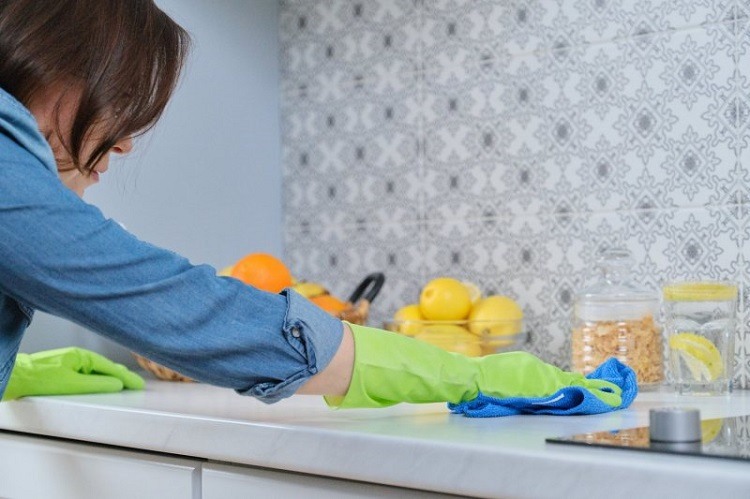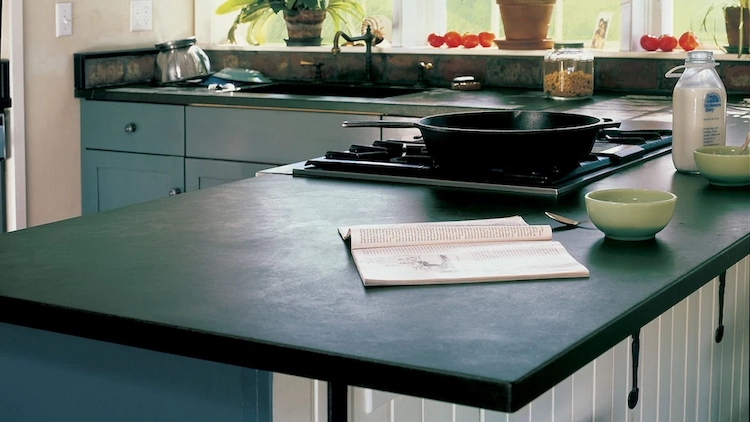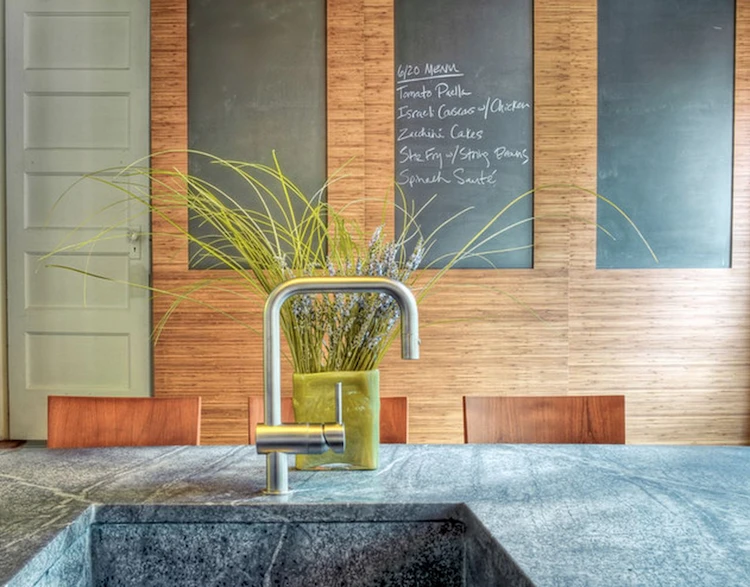When you clean soapstone countertops in the bathroom or kitchen, the cleaning process can sometimes leave scratches or dents. As one of the best materials with heat-resistant and stain-resistant properties, natural stone is suitable for a range of everyday household activities. However, its rather soft and non-porous structure requires special care when cleaning. The disadvantage of soapstone is that it is not as hard as other stones. Such surfaces are therefore more easily scratched and damaged. If you want to prevent this, you will find out below which cleaning methods are best suited for this and how you can repair any damage yourself.
How to avoid common mistakes and clean soapstone countertops
This building material consists mainly of the mineral talc, which has a unique texture. It is non-porous but heat resistant, making it ideal for kitchen worktops where heat is often present. Soapstone is also low maintenance, making it a great choice for people who don’t want to deal with the maintenance of stone varieties like granite or marble. Other minerals in soapstone include amphibole, carbonite, chlorite, mica, and pyroxene. The stone comes naturally in a variety of colors, including grays, browns, and shades of green and bluish, although all soapstone tends to darken over time. Its silky smooth appearance and soapy texture give soapstone its name.
There is a lot of conflicting information online about the best way for people to clean soapstone surfaces. It is just as important to understand the wrong cleaning methods and the right ones. One of the most common recommendations for cleaning soapstone countertops is to use mineral oil. While many people use this method, it will almost immediately result in such surfaces becoming darker. The first application can also be quite strenuous, because it takes a lot of effort for the mineral oil to penetrate the soapstone. In addition, some types of mineral oil may not be food safe as they are derived from petroleum products. They can also leave greasy marks on your countertops.
What cleaning tools and agents to avoid?
It’s also not a good idea to use harsh abrasive cleaners or sharp tools when cleaning soapstone countertops. Although natural stone is chemically inert and can therefore withstand acids, it can be scratched and nicked by strong abrasives. Additionally, it is never a good idea to use household cleaners that contain toxic chemicals in your kitchen, as the residual chemicals could come into contact with your food. If you want to keep your kitchen countertops clean, it’s best to find a safe and non-toxic product to seal and protect them. This should not darken and discolor surfaces like mineral oil does, nor leave a greasy residue on your countertops. So use the following tips to clean soapstone countertops and keep them looking good for years to come.
Follow these simple steps to clean soapstone countertops
Cleaning soapstone isn’t too difficult, but knowing how to treat it properly is important. For regular cleaning, the following cleaning method is most suitable:
- Add a few drops of dish soap in a bucket of warm water.
- Then wipe the soapstone surface with a clean sponge or microfiber cloth.
- Then rinse the cloth thoroughly or use another clean cloth to wipe away any excess soapy water from the countertop.
- Finally, allow the cleaned surface to dry.
Polishing and maintaining soapstone
Once your countertop or other soapstone surface is clean and dry, you can polish it with a polish. However, it should be specially developed for such stone countertops. Thus, you ensure that it does not damage the surface and contains non-toxic ingredients. You should apply the product with a clean cloth and then wipe away the excess – it’s as simple as that.
Although soapstone is naturally non-porous, it benefits from a beautifying finish to make colors shine and protect it from stains. Water, oil and greasy substances can cause discoloration and stains. You can apply the polish as often as necessary to maintain the beautiful appearance of your soapstone worktops. Such maintenance and care will minimize the likelihood of your countertops discoloring between uses for 3-6 months depending on use.
How to repair scratches or dents
Because soapstone is non-porous, food and acids will not stain the surface. However, if scratches do occur, rubbing the area with mineral oil will help hide such damage and discoloration from hard water stains. As mentioned above, mineral oil can also have a negative effect. However, you can follow the steps below to fix any damage. For this process you will need fine sandpaper, warm water, a sponge, soft clothing and mineral oil.
- If the surface of your soapstone becomes scratched, gently go over the scratch with a piece of fine sandpaper, using gentle, circular motions.
- Then dampen the sandpaper and sand the scratch again using a smooth, circular motion.
- First, soak a sponge in warm water and use it to wipe off any dust residue.
- Pour a small amount of mineral oil onto a soft cloth and rub into the area that has been sanded to restore its shine and natural dark color.
- Sanding removes the mineral oil and lightens the color, so you may need to apply the mineral oil several times to even out the color of the scratched and sanded area.
Additional soapstone maintenance tips and advice
- When the soapstone surface is new, you can expect it to darken over time. This is a natural process as the stone oxidizes and actually adds to the beauty of the surface. Most soapstone darkens to an anthracite gray, although some remain lighter, retaining a greenish tint.
- Unlike marble or granite, soapstone is naturally non-porous, hence its natural stain resistance, and does not need to be sealed.
- To make oiling even easier, store your oiled cloth in a ziplock bag. Over time, the cloth soaks up the oil and spreads it easier and more evenly over the soapstone surface.
- Because soapstone is prone to scratching, it is not recommended to use steel wool on it.
- Daily cleaning can be done with any household detergent and water.








